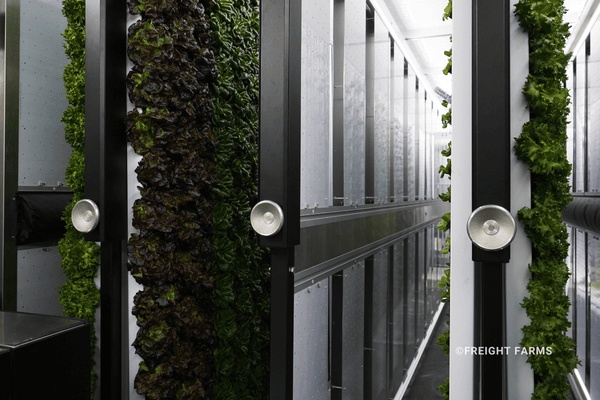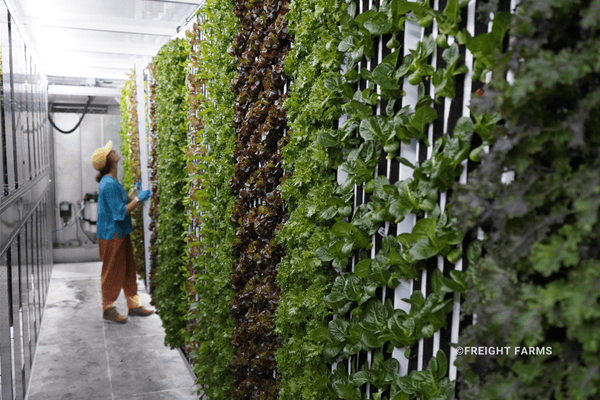Mastering Your Freight Farm's Crop Plan: A Guide to Success
Welcome to the world of Freight Farms! As vertical farming grows, so do the possibilities for crops you can cultivate in your farm. From leafy greens to herbs and even experimental crops, Freight Farms offers a vast range of options. However, with so many choices, it’s essential to start with a solid crop plan. Here’s how you can get started with crop planning, including tips on choosing crops that work well together and maximizing your farm’s potential.
Building the Perfect Crop Plan
Every crop has unique needs, and understanding those requirements is key to a successful harvest. To start, consult the Freight Farms Grow Guides before ordering seeds to help choose crops that suit your farm’s climate, water, and light conditions. Here’s a breakdown of what to keep in mind:
Climate Harmony
Since your Freight Farm operates with a single climate, choosing crops that thrive in the same environment is crucial. Some crops, like lettuce, prefer cooler temperatures, while others, like tomatoes, need warmth. Growing these two together would lead to one crop underperforming. However, compatible crops, like lettuce and basil, can co-exist as long as you adjust your growth strategy.
Water Preferences
Watering cycles greatly affect the development of your crops. Hardy crops tend to do well with less frequent watering, promoting strong root growth. But finding the balance is essential—too little water, and your crops may wilt; too much, and some varieties, like amaranth, may struggle. Pair crops with similar watering needs to ensure both grow well together.
Nutrient and Light Requirements
Your crops share the same nutrient solution, but their growth rates and flavor can be affected by how frequently they receive nutrients. Monitoring this through your farm's EC levels and completing regular water turnover ensures optimal growth. Light also plays a significant role—some crops, like spinach, thrive with shorter day cycles, while others, like lettuce, need more extended light exposure. Tailor your farm's lighting schedule to match your crops' specific needs.
Maximizing Yields with Farm Sectioning and Crop Scheduling
Sectioning your Farm
Dividing your farm into four sections—one per grow row—can streamline your operations. With this setup, you’ll harvest, transplant, and seed crops in a weekly rotation, ensuring a steady supply of produce while spreading out your labor.
Harvest Types: Whole Plant vs Trim Harvests
Not all crops are harvested the same way. Some, like lettuce, are harvested whole, while others, like kale, are trimmed, allowing for regrowth and multiple harvests. Choosing the right harvest method can impact your labor costs and overall crop schedule.
Intercropping: Maximizing Space and Efficiency
Intercropping is the practice of planting a small or fast-growing plant in between larger and slower-growing crops. This technique allows you to maximize the growing capacity of your farm while ensuring each crop has the proper amount of room to thrive. For example, root vegetables like radishes can be intercropped with leafy greens like kale or lettuce. This not only optimizes space but also keeps your farm on a consistent four-week growth cycle. By strategically pairing crops with complementary growth rates and space requirements, you can enhance overall productivity and maintain a balanced harvest schedule.
Exploring Crop Varieties: Cash, Specialty, and Experimental Crops
Cash Crops
Lettuce and leafy greens are the bread and butter of Freight Farms. They have a consistent demand year-round, making them a reliable choice for regular revenue.
Specialty Crops
Specialty crops, like herbs or edible flowers, command higher prices because they’re harder to source or not grown locally. These crops may take time to develop a customer base, so we recommend starting with just a few panels before scaling up.
Experimental Crops
If you’re feeling adventurous, experimental crops such as mushrooms or strawberries are always an option. While there’s less data available on these, you can always tap into the knowledge of the Freight Farms community to experiment and learn from others.
Stay Organized with farmhand®
Farmhand, our crop management tool, helps you visualize your crop plan, track your plants’ progress, and adjust as needed. With a well-structured crop schedule, you can stay organized and optimize your farm’s output.
Final Thoughts
Planning your crops may seem overwhelming at first, but by following these tips and consulting the Freight Farms community, you can develop a plan that works for you. Whether you’re growing cash crops for steady income, experimenting with specialty produce, or diving into more experimental varieties, a little planning goes a long way in achieving farming success.














